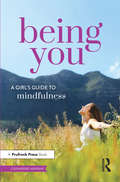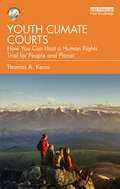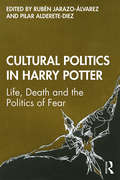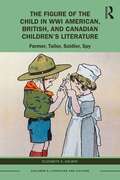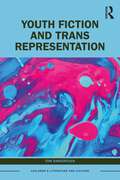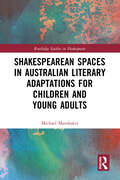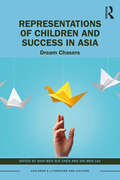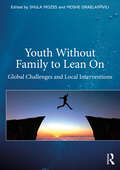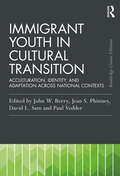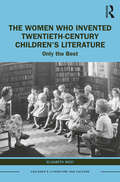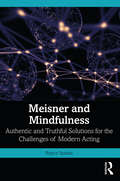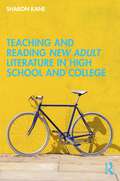- Table View
- List View
Being You: A Girl's Guide to Mindfulness
by Catharine HannayDo you ever feel stressed, anxious, or overwhelmed? As a teen girl, you're under a lot of pressure. Mindfulness can help. Being You explores mindfulness as a simple but powerful way to center oneself and tap into one's own inner wisdom and strength. This book:
Youth Climate Courts: How You Can Host a Human Rights Trial for People and Planet
by Thomas A. KernsThis book focuses on Youth Climate Courts, a bold new tool that young people in their teens and twenties can use to compel their local city or county government to live up to its human rights obligations, formally acknowledge the climate crisis, and take major steps to address it. Tom Kerns shows how youth climate leaders can form their own local Youth Climate Court, with youth judges, youth prosecuting attorneys, and youth jury members, and put their local city or county government on trial for not meeting its human rights obligations. Kerns describes how a Youth Climate Court works, how to start one, what human rights are, what they require of local governments, and what governmental changes a Youth Climate Court can realistically hope to accomplish. The book offers young activists a brand new, user-friendly, cost-free, barrier-free, powerful tool for forcing local governments to come to terms with their obligation to protect the rights of their citizens with respect to the climate crisis. This book offers a unique new tool to young climate activists hungry for genuinely effective ways to directly move governments to aggressively address the climate crisis.
Youth Climate Courts: How You Can Host a Human Rights Trial for People and Planet
by Thomas A. KernsThis book focuses on Youth Climate Courts, a bold new tool that young people in their teens and twenties can use to compel their local city or county government to live up to its human rights obligations, formally acknowledge the climate crisis, and take major steps to address it. Tom Kerns shows how youth climate leaders can form their own local Youth Climate Court, with youth judges, youth prosecuting attorneys, and youth jury members, and put their local city or county government on trial for not meeting its human rights obligations. Kerns describes how a Youth Climate Court works, how to start one, what human rights are, what they require of local governments, and what governmental changes a Youth Climate Court can realistically hope to accomplish. The book offers young activists a brand new, user-friendly, cost-free, barrier-free, powerful tool for forcing local governments to come to terms with their obligation to protect the rights of their citizens with respect to the climate crisis. This book offers a unique new tool to young climate activists hungry for genuinely effective ways to directly move governments to aggressively address the climate crisis.
Cultural Politics in Harry Potter: Life, Death and the Politics of Fear
by Rubén Jarazo-Álvarez Pilar Alderete-DiezCultural Politics in Harry Potter: Life, Death and the Politics of Fear is the first book-length analysis of topics, such as death, fear and biopolitics in J.K. Rowling’s work from controversial and interdisciplinary perspectives. This collection brings together recent theoretical and applied cultural studies and focuses on three key areas of inquiry: (1) wizarding biopolitics and intersected discourses; (2) anxiety, death, resilience and trauma; and (3) the politics of fear and postmodern transformations. As such, this book: provides a comprehensive overview of national and gender discourses, as well as the transiting bodies in-between, in relation to the Harry Potter books series and related multimedia franchise; situates the transformative power of death within the fandom, transmedia and film depictions of the Potterverse and critically deconstructs the processes of subjectivation and legitimation of death and fear; examines the strategies and mechanisms through which cultural and political processes are managed, as well as reminding us how fiction and reality intersect at junctions, such as terrorism, homonationalism, materialism, capitalism, posthumanism and technology. Exploring precisely what is cultural about wizarding politics, and what is political about culture, this book is key reading for students of contemporary literature, media and culture, as well as anyone with an interest in the fictional universe and wizarding world of Harry Potter.
The Figure of the Child in WWI American, British, and Canadian Children’s Literature: Farmer, Tailor, Soldier, Spy (Children's Literature and Culture)
by Elizabeth A. GalwayOver the past century, much attention has been paid to the literature written for adults in response to the First World War, but there has been comparatively little consideration of how the war influenced literature for young readers at the time. Based on extensive archival research, this study examines an array of wartime writing for young people and provides a new understanding of the complexities and nuances within children’s literature of the period. In its discussion of nearly 150 primary sources from Britain, Canada, and the United States, this volume considers some well-known texts but also brings to light forgotten children’s literature of the era, providing new insights into how WWI was presented to the young people whose lives were indelibly impacted by the crisis. Paying special attention to the varied ways in which child figures were depicted, it reflects on what these portrayals reveal about adult conceptualizations of youth, and it considers how these may have shaped young readers’ own views of armed conflict, citizenship, and childhood. From the helpless victim to the heroic combatant, child figures appeared in many guises, exposing a range of adult concerns about nation, empire, and children’s citizenship. Exploring everything from alphabet books for beginning readers, to recruitment materials for high school students, this book examines works from multiple genres and provides a uniquely comprehensive study of transatlantic children’s literature produced during the first global war.
The Figure of the Child in WWI American, British, and Canadian Children’s Literature: Farmer, Tailor, Soldier, Spy (Children's Literature and Culture)
by Elizabeth A. GalwayOver the past century, much attention has been paid to the literature written for adults in response to the First World War, but there has been comparatively little consideration of how the war influenced literature for young readers at the time. Based on extensive archival research, this study examines an array of wartime writing for young people and provides a new understanding of the complexities and nuances within children’s literature of the period. In its discussion of nearly 150 primary sources from Britain, Canada, and the United States, this volume considers some well-known texts but also brings to light forgotten children’s literature of the era, providing new insights into how WWI was presented to the young people whose lives were indelibly impacted by the crisis. Paying special attention to the varied ways in which child figures were depicted, it reflects on what these portrayals reveal about adult conceptualizations of youth, and it considers how these may have shaped young readers’ own views of armed conflict, citizenship, and childhood. From the helpless victim to the heroic combatant, child figures appeared in many guises, exposing a range of adult concerns about nation, empire, and children’s citizenship. Exploring everything from alphabet books for beginning readers, to recruitment materials for high school students, this book examines works from multiple genres and provides a uniquely comprehensive study of transatlantic children’s literature produced during the first global war.
Cultural Politics in Harry Potter: Life, Death and the Politics of Fear
by Rubén Jarazo-Álvarez Pilar Alderete-DiezCultural Politics in Harry Potter: Life, Death and the Politics of Fear is the first book-length analysis of topics, such as death, fear and biopolitics in J.K. Rowling’s work from controversial and interdisciplinary perspectives. This collection brings together recent theoretical and applied cultural studies and focuses on three key areas of inquiry: (1) wizarding biopolitics and intersected discourses; (2) anxiety, death, resilience and trauma; and (3) the politics of fear and postmodern transformations. As such, this book: provides a comprehensive overview of national and gender discourses, as well as the transiting bodies in-between, in relation to the Harry Potter books series and related multimedia franchise; situates the transformative power of death within the fandom, transmedia and film depictions of the Potterverse and critically deconstructs the processes of subjectivation and legitimation of death and fear; examines the strategies and mechanisms through which cultural and political processes are managed, as well as reminding us how fiction and reality intersect at junctions, such as terrorism, homonationalism, materialism, capitalism, posthumanism and technology. Exploring precisely what is cultural about wizarding politics, and what is political about culture, this book is key reading for students of contemporary literature, media and culture, as well as anyone with an interest in the fictional universe and wizarding world of Harry Potter.
Youth Fiction and Trans Representation (Children's Literature and Culture)
by Tom SandercockYouth Fiction and Trans Representation is the first book that wholly addresses the growth of trans and gender variant representation in literature, television, and films for children and young adults in the twenty-first century. Ranging across an array of media—including picture books, novels, graphic novels, animated cartoons, and live-action television and feature films—Youth Fiction and Trans Representation examines how youth texts are addressing and contributing to ongoing shifts in understandings of gender in the new millennium. While perhaps once considered inappropriate for youth, and continuing to face backlash, trans and gender variant representation in texts for young people has become more common, which signals changes in understandings of childhood and adolescence, as well as gender expression and identity. Youth Fiction and Trans Representation provides a broad outline of developments in trans and gender variant depictions for young people in the late twentieth and early twenty-first centuries and closely analyzes a series of millennial literary and screen texts to consider how they communicate a range of, often competing, ideas about gender, identity, expression, and embodiment to implied child and adolescent audiences.
Youth Fiction and Trans Representation (Children's Literature and Culture)
by Tom SandercockYouth Fiction and Trans Representation is the first book that wholly addresses the growth of trans and gender variant representation in literature, television, and films for children and young adults in the twenty-first century. Ranging across an array of media—including picture books, novels, graphic novels, animated cartoons, and live-action television and feature films—Youth Fiction and Trans Representation examines how youth texts are addressing and contributing to ongoing shifts in understandings of gender in the new millennium. While perhaps once considered inappropriate for youth, and continuing to face backlash, trans and gender variant representation in texts for young people has become more common, which signals changes in understandings of childhood and adolescence, as well as gender expression and identity. Youth Fiction and Trans Representation provides a broad outline of developments in trans and gender variant depictions for young people in the late twentieth and early twenty-first centuries and closely analyzes a series of millennial literary and screen texts to consider how they communicate a range of, often competing, ideas about gender, identity, expression, and embodiment to implied child and adolescent audiences.
Creating Meaning in Young Adulthood: The Self-Actualizing Power of Relationships
by Christopher J. KazanjianCreating Meaning in Young Adulthood explores the ways in which young adults are creating meanings in life through their relationships with the world. Chapters synthesize research in the fields of child psychology, counseling, multicultural education, and existential-humanistic psychology to offer readers a contemporary understanding of the greater challenges for growth and development that youth currently face. Using ample case studies, the book also sets forth a resilience-based approach for helping readers facilitate the healing, growth, and enlightenment of young adults.
Creating Meaning in Young Adulthood: The Self-Actualizing Power of Relationships
by Christopher J. KazanjianCreating Meaning in Young Adulthood explores the ways in which young adults are creating meanings in life through their relationships with the world. Chapters synthesize research in the fields of child psychology, counseling, multicultural education, and existential-humanistic psychology to offer readers a contemporary understanding of the greater challenges for growth and development that youth currently face. Using ample case studies, the book also sets forth a resilience-based approach for helping readers facilitate the healing, growth, and enlightenment of young adults.
Shakespearean Spaces in Australian Literary Adaptations for Children and Young Adults (Routledge Studies in Shakespeare)
by Michael MarokakisShakespearean Spaces in Australian Literary Adaptations for Children and Young Adults offers a comprehensive examination of Shakespearean adaptations written by Australian authors for children and Young Adults. The 20-year period crossing the late-twentieth and early twenty-first centuries came to represent a diverse and productive era of adapting Shakespeare in Australian literature. As an analysis of Australian and international marketplaces, physical and imaginative spaces and the body as a site of meaning, this book reveals how the texts are ideologically bound to and disseminate Shakespearean cultural capital in contemporary ways. Combining current research in children’s literature and Bourdieu’s theory of cultural capital deepens the critical awareness of the status of Australian literature while illuminating a corpus of literature underrepresented by the pre-existing concentration on adaptations from other parts of the world. Of particular interest is how these adaptations merge Shakespearean worlds with the spaces inhabited by young people, such as the classroom, the stage, the imagination and the gendered body. The readership of this book would be academics, researchers and students of children’s literature studies and Shakespeare studies, particularly those interested in Shakespearean cultural theory, transnational adaptation and literary appropriation. High school educators and pre-service teachers would also find this book valuable as they look to broaden and strengthen their use of adaptations to engage students in Shakespeare studies.
Shakespearean Spaces in Australian Literary Adaptations for Children and Young Adults (Routledge Studies in Shakespeare)
by Michael MarokakisShakespearean Spaces in Australian Literary Adaptations for Children and Young Adults offers a comprehensive examination of Shakespearean adaptations written by Australian authors for children and Young Adults. The 20-year period crossing the late-twentieth and early twenty-first centuries came to represent a diverse and productive era of adapting Shakespeare in Australian literature. As an analysis of Australian and international marketplaces, physical and imaginative spaces and the body as a site of meaning, this book reveals how the texts are ideologically bound to and disseminate Shakespearean cultural capital in contemporary ways. Combining current research in children’s literature and Bourdieu’s theory of cultural capital deepens the critical awareness of the status of Australian literature while illuminating a corpus of literature underrepresented by the pre-existing concentration on adaptations from other parts of the world. Of particular interest is how these adaptations merge Shakespearean worlds with the spaces inhabited by young people, such as the classroom, the stage, the imagination and the gendered body. The readership of this book would be academics, researchers and students of children’s literature studies and Shakespeare studies, particularly those interested in Shakespearean cultural theory, transnational adaptation and literary appropriation. High school educators and pre-service teachers would also find this book valuable as they look to broaden and strengthen their use of adaptations to engage students in Shakespeare studies.
Representations of Children and Success in Asia: Dream Chasers (Children's Literature and Culture)
by Shih-Wen Sue Chen Sin Wen LauThis edited volume explores how success is conceptualized and represented in texts for young people in Asia. The essays in this collection examine how success for children relates to education, family, gender, race, class, community, and the nation. It answers the following questions: How is success for children represented in literature, cinema, and popular media? In what ways are these images grounded in the historical, political, and cultural contexts in which they are produced and consumed? How does childhood agency influence ideas about success in Asia? Highlighting the similarities and differences in how success is defined for children and young adults in Japan, South Korea, People’s Republic of China, Singapore, Taiwan, Indonesia, Vietnam, and India, this volume argues that success is an important keyword in the literary and cultural study of childhood in Asia.
Representations of Children and Success in Asia: Dream Chasers (Children's Literature and Culture)
by Sue Chen, Shih-Wen and Wen Lau, SinThis edited volume explores how success is conceptualized and represented in texts for young people in Asia. The essays in this collection examine how success for children relates to education, family, gender, race, class, community, and the nation. It answers the following questions: How is success for children represented in literature, cinema, and popular media? In what ways are these images grounded in the historical, political, and cultural contexts in which they are produced and consumed? How does childhood agency influence ideas about success in Asia? Highlighting the similarities and differences in how success is defined for children and young adults in Japan, South Korea, People’s Republic of China, Singapore, Taiwan, Indonesia, Vietnam, and India, this volume argues that success is an important keyword in the literary and cultural study of childhood in Asia.
Youth Without Family to Lean On: Global Challenges and Local Interventions
by Moshe Israelashvili Shula MozesYouth Without Family to Lean On draws together interdisciplinary, global perspectives to provide a comprehensive review of the characteristics, dynamics, and development of youth (aged 15–25) who have no family to lean on, either practically or psychologically.In this timely volume, Mozes and Israelashvili bring together leading international experts to present updated knowledge, information on existing interventions, and unanswered questions in relation to youth without family to lean on, in pursuit of fostering these youth’s positive development. The various chapters in this book include discussions on different topics such as social support, developing a sense of belonging, parental involvement, and internalized vs. externalized problems; on populations, including homeless youth, residential care-leavers, refugees, asylum-seekers, young women coming from vulnerable families, and school dropouts; and interventions to promote these youths' mentoring relationships, labor market attainment, out-of-home living placements, use of IT communication, and participation in community-based programs. Additionally, various problems and challenges are presented and elaborated on, such as: Who needs support? Who is qualified to provide support? How should related interventions be developed? The book takes a preventive approach and aims to emphasize steps that can be taken in order to promote young people’s positive development in spite of the absence of a family to rely on in their life and examines the best practices in this context, as well as the international lessons that deserve further dissemination and exploration. This book is essential reading for those in psychology, sociology, public health, social work, law, criminology, public policy, economics, and education and is highly enriching for scholars and practitioners, as well as higher education students, who wish to understand and help the gradually increasing number of youth who are forced, too early, to manage their life alone.
Youth Without Family to Lean On: Global Challenges and Local Interventions
by Shula Mozes Moshe IsraelashviliYouth Without Family to Lean On draws together interdisciplinary, global perspectives to provide a comprehensive review of the characteristics, dynamics, and development of youth (aged 15–25) who have no family to lean on, either practically or psychologically.In this timely volume, Mozes and Israelashvili bring together leading international experts to present updated knowledge, information on existing interventions, and unanswered questions in relation to youth without family to lean on, in pursuit of fostering these youth’s positive development. The various chapters in this book include discussions on different topics such as social support, developing a sense of belonging, parental involvement, and internalized vs. externalized problems; on populations, including homeless youth, residential care-leavers, refugees, asylum-seekers, young women coming from vulnerable families, and school dropouts; and interventions to promote these youths' mentoring relationships, labor market attainment, out-of-home living placements, use of IT communication, and participation in community-based programs. Additionally, various problems and challenges are presented and elaborated on, such as: Who needs support? Who is qualified to provide support? How should related interventions be developed? The book takes a preventive approach and aims to emphasize steps that can be taken in order to promote young people’s positive development in spite of the absence of a family to rely on in their life and examines the best practices in this context, as well as the international lessons that deserve further dissemination and exploration. This book is essential reading for those in psychology, sociology, public health, social work, law, criminology, public policy, economics, and education and is highly enriching for scholars and practitioners, as well as higher education students, who wish to understand and help the gradually increasing number of youth who are forced, too early, to manage their life alone.
Immigrant Youth in Cultural Transition: Acculturation, Identity, and Adaptation Across National Contexts (Psychology Press & Routledge Classic Editions)
by John W. Berry Jean S. Phinney David L. Sam Paul VedderThe Classic Edition of 'Immigrant Youth in Cultural Transition', first published in 2006, includes a new introduction by the editors, describing the ongoing relevance of this volume in the context of future challenges for this vital field of study. It emphasizes the importance of continued actions and policies to improve the quality of interactions between multiple ethno-cultural groups, and highlights how these issues have developed the field of cross-cultural psychology. In the original text, an international team of psychologists with interests in acculturation, identity, and development describes the experience and adaptation of immigrant youth, using data from over 7,000 immigrant youth from diverse cultural backgrounds and national youth living in 13 countries of settlement. They explore the way in which immigrant adolescents carry out their lives at the intersection of two cultures (those of their heritage group and the national society), and how well these youth are adapting to their intercultural experience. It explores four distinct patterns followed by youth during their acculturation: *an integration pattern, in which youth orient themselves to, and identify with both cultures; *an ethnic pattern, in which youth are oriented mainly to their own group; *a national pattern, in which youth look primarily to the national society; and *a diffuse pattern, in which youth are uncertain and confused about how to live interculturally. The study shows the variation in both the psychological adaptation and the sociocultural adaptation among youth, with most adapting well. This Classic Edition continues to be highly valuable reading for researchers, graduate students, and public policy makers who have an interest in public health, psychology, anthropology, sociology, demography, education, and psychiatry.
Immigrant Youth in Cultural Transition: Acculturation, Identity, and Adaptation Across National Contexts (Psychology Press & Routledge Classic Editions)
by John W. Berry Jean S. Phinney David L. Sam Paul VedderThe Classic Edition of 'Immigrant Youth in Cultural Transition', first published in 2006, includes a new introduction by the editors, describing the ongoing relevance of this volume in the context of future challenges for this vital field of study. It emphasizes the importance of continued actions and policies to improve the quality of interactions between multiple ethno-cultural groups, and highlights how these issues have developed the field of cross-cultural psychology. In the original text, an international team of psychologists with interests in acculturation, identity, and development describes the experience and adaptation of immigrant youth, using data from over 7,000 immigrant youth from diverse cultural backgrounds and national youth living in 13 countries of settlement. They explore the way in which immigrant adolescents carry out their lives at the intersection of two cultures (those of their heritage group and the national society), and how well these youth are adapting to their intercultural experience. It explores four distinct patterns followed by youth during their acculturation: *an integration pattern, in which youth orient themselves to, and identify with both cultures; *an ethnic pattern, in which youth are oriented mainly to their own group; *a national pattern, in which youth look primarily to the national society; and *a diffuse pattern, in which youth are uncertain and confused about how to live interculturally. The study shows the variation in both the psychological adaptation and the sociocultural adaptation among youth, with most adapting well. This Classic Edition continues to be highly valuable reading for researchers, graduate students, and public policy makers who have an interest in public health, psychology, anthropology, sociology, demography, education, and psychiatry.
The Women Who Invented Twentieth-Century Children’s Literature: Only the Best (Children's Literature and Culture)
by Elizabeth WestPublishing for children between 1930 and 1960 has been denigrated as a relatively fallow period for creativity and quality, certainly in comparison with the ‘golden ages’ of children’s literature that preceded and succeeded it. This book questions this perception by using archival evidence to argue that the work of what was predominantly a female group of editors, illustrators, authors and librarians (collectively referred to as bookwomen) resulted in many titles which are still considered as ‘classics’ today. The bookwomen reframed ideas about how children’s publishing should be approached and valued and, in doing so, laid the foundations for a subsequent generation of children’s authors and publishers who were to achieve far greater prominence. The key to the success of the bookwomen was their willingness to experiment, the strength of their relationships and their comprehensive understanding of the book production process. By focusing on a selection of women working across all aspects of the book production process, this book demonstrates that, both individually and collectively, women capitalised on their position as ‘other’ to the existing male institutions.
The Women Who Invented Twentieth-Century Children’s Literature: Only the Best (Children's Literature and Culture)
by Elizabeth WestPublishing for children between 1930 and 1960 has been denigrated as a relatively fallow period for creativity and quality, certainly in comparison with the ‘golden ages’ of children’s literature that preceded and succeeded it. This book questions this perception by using archival evidence to argue that the work of what was predominantly a female group of editors, illustrators, authors and librarians (collectively referred to as bookwomen) resulted in many titles which are still considered as ‘classics’ today. The bookwomen reframed ideas about how children’s publishing should be approached and valued and, in doing so, laid the foundations for a subsequent generation of children’s authors and publishers who were to achieve far greater prominence. The key to the success of the bookwomen was their willingness to experiment, the strength of their relationships and their comprehensive understanding of the book production process. By focusing on a selection of women working across all aspects of the book production process, this book demonstrates that, both individually and collectively, women capitalised on their position as ‘other’ to the existing male institutions.
Meisner and Mindfulness: Authentic and Truthful Solutions for the Challenges of Modern Acting
by Royce SparksMeisner and Mindfulness: Authentic and Truthful Solutions for the Challenges of Modern Acting is the first book that reveals how Meisner and mindfulness can be united to create strong results for actors and help them navigate the challenges of the digital age. The twenty-first century has created an entirely new set of demands and pressures on the working actor, including an acceleration of the digital age and the complications of COVID-19, which have led to auditions, rehearsals, and even whole performances happening entirely in isolation. This book combines a modern rethinking of the Meisner technique with a complementary set of tools from mindfulness meditation to offer profound solutions to these growing challenges, addressing the demands of a post-coronavirus industry as well as the pressures of acting in the digital era. In this ground-breaking expansion of the technique, readers will discover how it is possible to train some of the deepest values of living truthfully under a given set of circumstances, both with other actors and whilst alone. Since the 1950s the Meisner technique has aided the actor in navigating the demands unique to their time. This book is a powerful reminder that, even in the midst of so many changes and challenges, the truthfulness that has defined outstanding performances across generations is still within reach. Full of easily accessible mindfulness and Meisner exercises and principles for practice-based support, Meisner and Mindfulness will be illuminating to working actors, directors, students and instructors of acting, and practitioners of the Meisner technique looking to develop the authenticity, immediateness, and closeness essential to great acting. The book also includes access to an online supplement featuring additional exercises and concepts, including new ways to incorporate Meisner exercises into training sessions, suggestions for how Meisner-oriented companies can use exercises such as repetition in rehearsals, and discussions for how to set up a facilitated Meisner group.
Meisner and Mindfulness: Authentic and Truthful Solutions for the Challenges of Modern Acting
by Royce SparksMeisner and Mindfulness: Authentic and Truthful Solutions for the Challenges of Modern Acting is the first book that reveals how Meisner and mindfulness can be united to create strong results for actors and help them navigate the challenges of the digital age. The twenty-first century has created an entirely new set of demands and pressures on the working actor, including an acceleration of the digital age and the complications of COVID-19, which have led to auditions, rehearsals, and even whole performances happening entirely in isolation. This book combines a modern rethinking of the Meisner technique with a complementary set of tools from mindfulness meditation to offer profound solutions to these growing challenges, addressing the demands of a post-coronavirus industry as well as the pressures of acting in the digital era. In this ground-breaking expansion of the technique, readers will discover how it is possible to train some of the deepest values of living truthfully under a given set of circumstances, both with other actors and whilst alone. Since the 1950s the Meisner technique has aided the actor in navigating the demands unique to their time. This book is a powerful reminder that, even in the midst of so many changes and challenges, the truthfulness that has defined outstanding performances across generations is still within reach. Full of easily accessible mindfulness and Meisner exercises and principles for practice-based support, Meisner and Mindfulness will be illuminating to working actors, directors, students and instructors of acting, and practitioners of the Meisner technique looking to develop the authenticity, immediateness, and closeness essential to great acting. The book also includes access to an online supplement featuring additional exercises and concepts, including new ways to incorporate Meisner exercises into training sessions, suggestions for how Meisner-oriented companies can use exercises such as repetition in rehearsals, and discussions for how to set up a facilitated Meisner group.
Teaching and Reading New Adult Literature in High School and College
by Sharon KaneAn introduction to the rapidly growing category of New Adult (NA) literature, this text provides a roadmap to understanding and introducing NA books to young people in high school, college, libraries, and other settings. As a window into the experiences and unique challenges that young and new adults encounter, New Adult literature intersects with but is distinct from Young Adult literature. This rich resource provides a framework, methods, and plentiful reading recommendations by genre, theme, and discipline on New Adult literature. Starting with a definition of New Adult literature, Kane demonstrates how the inclusion of NA literature helps support and encourage a love of reading. Chapters address important topics that are relevant to young people, including post-high school life, early careers, relationships, activism, and social change. Each chapter features text sets, instructional strategies, writing prompts, and activities to invite and encourage young people to be reflective and engaged in responding to thought-provoking texts. A welcome text for professors of literacy and literature instruction, first-year college instructors, researchers, librarians, and educators, this book provides new ways to assist students as they embark upon the next stage of their lives and is essential reading for courses on teaching literature.
Teaching and Reading New Adult Literature in High School and College
by Sharon KaneAn introduction to the rapidly growing category of New Adult (NA) literature, this text provides a roadmap to understanding and introducing NA books to young people in high school, college, libraries, and other settings. As a window into the experiences and unique challenges that young and new adults encounter, New Adult literature intersects with but is distinct from Young Adult literature. This rich resource provides a framework, methods, and plentiful reading recommendations by genre, theme, and discipline on New Adult literature. Starting with a definition of New Adult literature, Kane demonstrates how the inclusion of NA literature helps support and encourage a love of reading. Chapters address important topics that are relevant to young people, including post-high school life, early careers, relationships, activism, and social change. Each chapter features text sets, instructional strategies, writing prompts, and activities to invite and encourage young people to be reflective and engaged in responding to thought-provoking texts. A welcome text for professors of literacy and literature instruction, first-year college instructors, researchers, librarians, and educators, this book provides new ways to assist students as they embark upon the next stage of their lives and is essential reading for courses on teaching literature.
